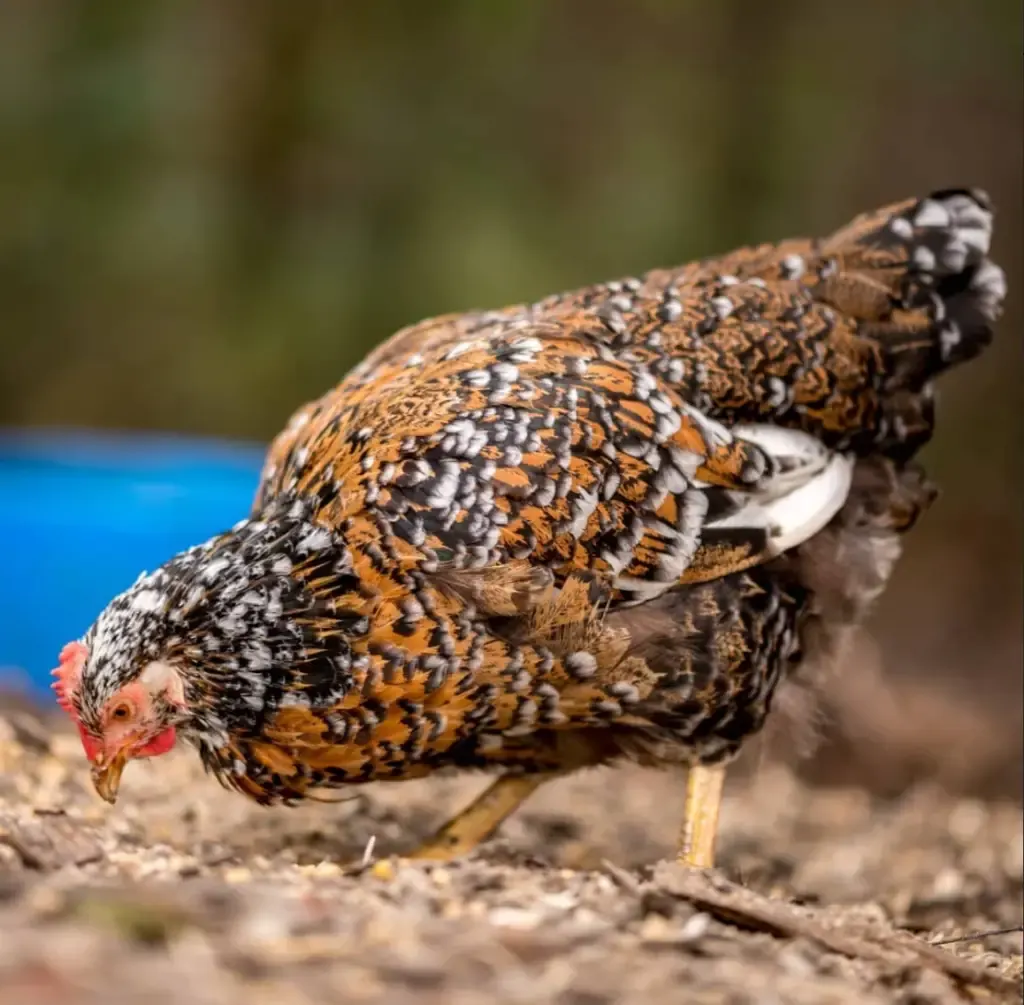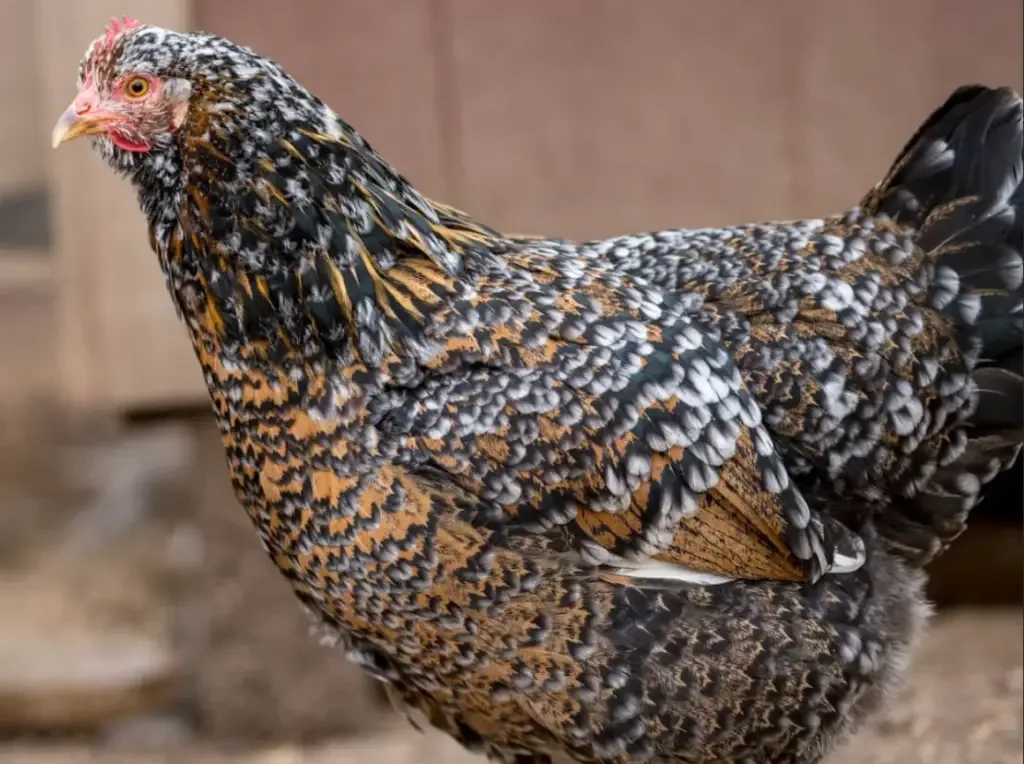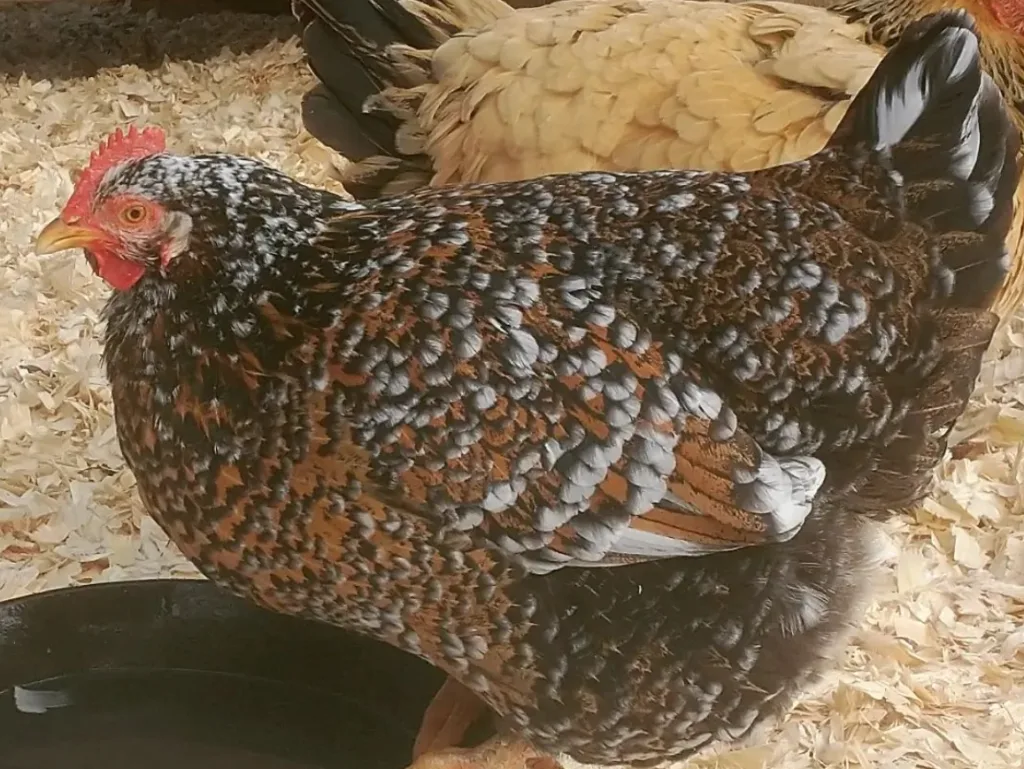The Swedish Flower Hen is a unique and captivating breed of chicken that has been gaining popularity among chicken enthusiasts in recent years.
Originating from Sweden, this breed is known for its distinct and colorful feather patterns, which can vary greatly from bird to bird.
Despite being a rare breed, the Swedish Flower Hen is a formidable dual-purpose bird, with excellent egg-laying abilities and good meat production.
They are also known for their friendly and docile temperament, making them great pets for families with children.
If you are considering adding a Swedish Flower Hen to your flock, it is important to do your research and learn about their specific care requirements.
In this article, we will discuss:
- Swedish Flower Hen overview and history
- The physical characteristics of the Swedish Flower Hen
- Their behavior and temperament
- Swedish Flower Hen care requirements
- And some frequently asked questions

Swedish Flower Hen Overview
| Lifespan | 5-7 years |
| Weight | Hen: 5-6 lbs, Rooster: 7-8 lbs |
| Appearance | Feathers are black, blue, brown, orange, or red base with white tips |
| Egg Color | Cream or light brown |
| Egg Size | Large to Extra Large |
| Egg Production | 150-200 eggs per year (3-5 per week) |
| Broodiness Level | Medium |
| Beginner Friendly | Yes |
| Space Needed | 4 square feet per bird inside the coop, 8 square feet outdoors |
| Price | $20-$30 per chick |
Swedish Flower Hen Origin & History
The Swedish Flower Hen is an ancient landrace breed of chicken (adapted naturally and not human-engineered) that has been around for over 300 years.
The breed is believed to have originated in southern Sweden, specifically in the landskap of Skåne.
This chicken’s name is derived from the speckles or “flowers” on the tips of their feathers.
The breed was first mentioned in folklore literature in the 1700s, and it is likely that the Romans brought chickens to Sweden, including the ancestors of the Swedish Flower Hen.
They were also almost extinct in the 1970s, but its recovery was based on three flocks found in the villages of Esarp, Tofta, and Vomb, all in Skåne.
Geographical Influence
The Swedish Flower Hen’s appearance can vary tremendously from one bird to the next.
The Swedes found the original flocks in three areas: Vomb, where crested fowl were found, and Esarp and Tofta, where non-crested fowl were located.
As a result, the breed displays both crested and non-crested birds.
The breed’s geographical location has also influenced its characteristics.
The harsh climate and short summers in Skåne have resulted in a breed that is hardy and adaptable to different weather conditions.
The Swedish Flower Hen is also known for its foraging abilities, which have been honed over centuries of free-ranging on Swedish farms.
Swedish Flower Hen Appearance
The Swedish Flower Hen is a unique breed known for its distinctive feather color and pattern.
They have a medium-sized, rectangular body shape with large, dark eyes.
These birds also have a short and curved beak and their legs are yellow and sparsely feathered.
The base color of their feathers can be black, blue, brown, orange, or red. Typically, their feathers are a mix of black, white, and brown in a millefleur pattern.
The tips of their feathers create white and brown patterns that look like spots, which are unique to each bird and some won’t have any spots at all.
The Snow Leopard Swedish Flower Hen is the rarest color variety, with spots that are a mix of white, black, and gold.
Size and Weight
The Swedish Flower Hen is a medium-sized breed, with hens weighing around 5.5 pounds (2.5 kg) and roosters weighing around 7.5 pounds (3.5 kg).
They have a rounded and robust body, with clean legs and a single red comb.
The comb can be floppy or less floppy, and they have red wattles and white earlobes.
Compared to other chicken breeds, the Swedish Flower Hen is relatively large, but they are not as heavy as some of the more popular dual-purpose breeds.
They are known for their excellent egg-laying abilities, and their medium size makes them easy to handle and care for.

Swedish Flower Hen Breed Standard
The Swedish Flower Hen is a landrace breed of domestic chicken that originated in southern Sweden.
This breed is known for its unique and colorful plumage, which resembles meadow flowers.
The breed standard for the Swedish Flower Hen has been established by the Swedish Poultry Breeders Association and is used as a guide for breeders to maintain the breed’s unique characteristics.
In America, there is no official breed standard yet, as the American Poultry Association has not recognized them yet as an official breed.
Different breeders are currently working on getting this breed standardized, however doing so may significantly affect the standards of their appearance.
Behavior and Temperament
The Swedish Flower Hen is known for its friendly and curious nature, making it an excellent choice for backyard flocks.
This breed is typically known for being:
- Confident
- Calm
- Curious
- Independent
- Smart
They are an active breed, always on the move, and love to forage and explore their surroundings.
These chickens are not flighty and are easy to handle, making them a great choice for families with children.
They are also known for being good mothers and are sometimes used as broody hens to hatch eggs.
Social Behavior
Swedish Flower Hens are social creatures and enjoy being around other chickens.
They are not aggressive and will get along well with other breeds.
These chickens are also known for their gentle nature and will often seek out human interaction.
They are not overly demanding and will be content to spend time with their owners or other chickens.
Noise Level
Swedish Flower Hens are not known for being particularly noisy.
They will make the usual clucking and crowing sounds, but they are not excessively loud.
These chickens are not prone to excessive squawking or other loud noises, making them a good choice for urban or suburban environments.

Egg Laying Capabilities
Swedish Flower Hens are known for their excellent egg-laying capabilities. In this section, we will discuss their egg production, egg size, and egg color.
Egg Production
The Swedish Flower Hen is a good layer, with hens laying between 150-200 eggs per year.
Their eggs are large to extra large-sized and are light brown or cream in color.
The eggs are known for having a rich and flavorful taste, making them a popular choice for backyard egg production.
Their egg-laying season typically starts in the spring and lasts through the fall.
During the winter months, their egg production may decrease due to shorter days.
Egg Size
Swedish Flower Hens lay eggs that start out small but quickly increase in size.
Their eggs are known to be extra-large, weighing between 60 and 80 grams.
This makes them a great choice for those who enjoy larger eggs for cooking or baking.
Egg Color
Swedish Flower Hens lay eggs that are a light shade of beige, which is a unique color that can add variety to your egg collection.
The color of their eggs can vary slightly depending on their diet and other factors, but they generally have a consistent light beige color.
Health and Lifespan
Common Health Issues
Like any other chicken breed, the Swedish Flower Hen is susceptible to certain health issues.
However, with proper care and attention, most of these issues can be prevented or treated effectively.
Here are some of the common health issues that may affect Swedish Flower Hens:
- Egg Binding: This is a condition where the hen is unable to lay an egg due to a blockage in the reproductive tract. It can be caused by various factors such as poor diet, lack of exercise, or genetics. Symptoms include lethargy, loss of appetite, and straining to lay an egg. Treatment involves providing warm baths, lubrication, and in severe cases, surgery.
- Mites and Lice: These are external parasites that feed on the chicken’s blood and can cause irritation, anemia, and other health problems. Symptoms include feather loss, irritation, and restlessness. Treatment involves using insecticides and keeping the coop clean and dry.
- Respiratory Infections: These are common in chickens and can be caused by bacteria, viruses, or fungi. Symptoms include coughing, sneezing, nasal discharge, and difficulty breathing. Treatment involves isolating the sick bird, providing supportive care, and administering antibiotics if necessary.
Average Lifespan
Swedish Flower Hens have an average lifespan of 5-7 years, although some may live longer with proper care and attention.
Factors that can affect their lifespan include genetics, diet, environment, and healthcare.
To ensure a long and healthy life for your Swedish Flower Hen, it is important to provide them with a balanced diet, clean and spacious living conditions, and regular veterinary check-ups.
Additionally, providing them with opportunities to engage in natural behaviors like scratching, dust bathing, and foraging can also improve their overall health and well-being.

Care and Maintenance
When it comes to taking care of Swedish Flower Hens, there are a few things to keep in mind.
Proper feeding, housing, and handling are essential to keeping these chickens healthy and happy.
Feeding
Swedish Flower Hens require a balanced diet that includes a mix of protein, carbohydrates, and fats.
A good quality commercial feed that is specifically formulated for laying hens is a good place to start.
It’s also important to provide your hens with fresh water at all times.
In addition to commercial feed, Swedish Flower Hens enjoy a variety of treats such as fruits, vegetables, and grains.
They can eat treats, snacks, and table scraps that consist of:
- Watermelon
- Pinneaple
- Plums
- Kiwis
- Celery
- Green beans
- Berries
- Cucumber
- Leafy greens
- Mealworms
- Black fly larvae
- Chicken grit
- Crushed oyster shells
- Seeds
- And many more
However, treats and snacks should only make up about 10%-20% of their overall diet, as overfeeding can lead to obesity and other health problems.
Coop Setup
Swedish Flower Hens are adaptable to a variety of living conditions, but they do require adequate space and protection from the elements.
A coop that is at least 4 square feet per bird and a run that is at least 8 square feet per bird is recommended.
The coop should be well-ventilated but also provide protection from drafts and predators.
It’s important to keep the coop clean and dry to prevent the spread of disease.
Free Ranging
Swedish Flower Hens love the space to forage and free range.
As stated above, each chicken requires at least 8 square feet of space while free ranging.
Handling
Swedish Flower Hens are generally docile and friendly, but proper handling is still important to prevent injury to both the chicken and the handler.
It’s important to approach the chicken calmly and gently and to support their body when picking them up.
Regular handling can also help to socialize your chickens and make them more comfortable around humans.
However, it’s important to avoid over-handling or stressing your chickens out, as this can lead to health problems.
Overall, with proper care and maintenance, Swedish Flower Hens can make wonderful additions to any backyard flock.
Breeding Swedish Flower Hen
Breeding Swedish Flower Hens is a fascinating process that requires patience and attention to detail.
This section will cover the breeding process and genetic diversity of Swedish Flower Hens.
Breeding Process
Breeding Swedish Flower Hens involves selecting the best male and female birds to produce offspring with desirable traits.
The breeding process can be done naturally or artificially.
Natural breeding involves allowing the male and female birds to mate naturally, while artificial breeding involves collecting sperm from the male and inseminating the female.
Before breeding, it is important to ensure that the birds are healthy and free from any diseases.
It is also important to consider the genetic diversity of the breeding stock to prevent inbreeding and maintain a healthy population.
Once the breeding process is complete, the eggs are collected and incubated until they hatch.
The chicks are then raised in a safe and healthy environment until they reach maturity.
Genetic Diversity
Maintaining genetic diversity is crucial when breeding Swedish Flower Hens.
This helps to prevent inbreeding and maintain a healthy population.
Inbreeding can lead to a decrease in genetic diversity, which can result in health problems and reduced fertility.
One way to maintain genetic diversity is to introduce new birds into the breeding population.
This can be done by purchasing birds from other breeders or by hatching eggs from different breeding lines.
Another way to maintain genetic diversity is to keep detailed records of the breeding process.
This includes recording the breeding pairs, the number of offspring produced, and any genetic traits that are passed down from generation to generation.
Final Thoughts
Overall, the Swedish Flower Hen is a unique and beautiful breed that is worth considering for any backyard flock.
They are known for their striking feather patterns and friendly personalities, making them a great addition to any homestead.
Here are some key takeaways to keep in mind:
- Swedish Flower Hens are a dual-purpose breed that are excellent for both meat and egg production.
- They are a hardy breed that can tolerate cold weather well.
- Their unique feather pattern makes them stand out in any flock.
- They are docile and friendly, making them a great choice for families with children.
- While they are not as well known as other breeds, their popularity has been growing in recent years.
If you are looking for a unique and beautiful breed that is also practical for meat and egg production, the Swedish Flower Hen is definitely worth considering.
With their friendly personalities and striking appearance, they are sure to be a hit with both adults and children alike.
Frequently Asked Questions
What color eggs do Swedish Flower Hens lay?
Swedish Flower Hens lay cream to light brown-colored eggs.
The color of the eggs may vary slightly depending on the individual hen.
Are Swedish Flower Hens rare?
Swedish Flower Hens were once considered a rare breed, but their popularity has been increasing in recent years.
They are still not as common as some other breeds, but they are becoming more widely available.
What are Swedish Flower Hens?
Swedish Flower Hens are a breed of domestic chicken that originated in Sweden.
They are known for their unique and colorful feather patterns, which can vary greatly from bird to bird.
At what age do Swedish Flower Hens start laying?
Swedish Flower Hens start laying around 16-17 weeks old.
Their first few eggs may be smaller and inconsistent, but as they mature, they will consistently lay 150-200 large eggs per year.
What is the difference between a Swedish Flower Hen and a rooster?
A Swedish Flower Hen is a female chicken, while a rooster is a male chicken.
Roosters are typically larger and more brightly colored than hens, but they do not have the same unique feather patterns as Swedish Flower Hens.
Where can I find Swedish Flower Hen eggs for sale?
Swedish Flower Hen eggs can be found for sale from a variety of sources, including hatcheries and breeders.
It is important to purchase eggs from a reputable source to ensure the health and quality of the chicks that hatch.

